Charles Morgan contacted the Museum of UnCut Funk back in July of this year. He informed us of articles that he and Hubert Walker had written for CoinWeek.com on Blacks on coins. CoinWeek.com is an on-line media source for print and video news about rare coins and currency. We are thrilled to have experts like Mr. Morgan and Mr. Walker recognize the Museum of UnCut Funk and our Black coin and medals collection.
Thank you Mr. Morgan and Mr. Walker for giving the Museum of UnCut Funk this great opportunity to reprint your work.
When we sit down to write, we have a few guiding principles. One of our basic assumptions is that the market for modern American coinage is underdeveloped and undervalued. It’s a market full of opportunities for anyone with an eye for value investing and collectors with a soft spot for the underdog. We like seeking these opportunities out and putting it all out there. There’s something democratic about showing people they can still find worthwhile coins in their pocket change. And putting moderns under the microscope like we do leads to some interesting observations.
For instance, did you know that an African-American wasn’t honored on a business-strike coin until Duke Ellington on the reverse of the 2009 Washington, D.C. District of Columbia and U.S. Territories quarter? It’s true… soft of; the story gets complicated. Fact is, there’s an untold story behind the role of African-Americans on our coinage that isn’t familiar to most people. From the beautiful goddess-like body forever immortalized on one of the United States’ most significant designs, to a recent commemorative featuring nine courageous children whose footsteps changed the world, there’s a lot we don’t realize about the people on our coins and why they’re there. Our next two articles will focus on this fascinating history.
A First… but Why?
From Slave Cabin to Hall of Fame: The long-running Booker T. Washington Commemorative half dollar
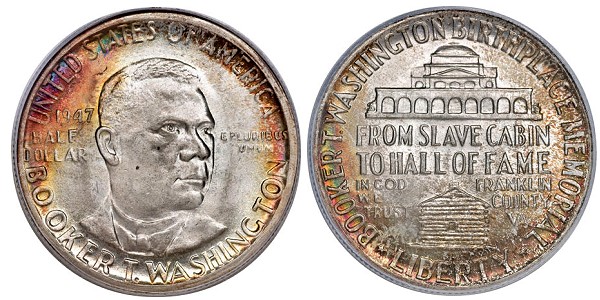
Large mintages for certain issues leave many believing that the BTW half is common, but surprise! Many coins in the series have net mintages below 8,000[1].
Doing the research convinced us to take a step back for a moment and write about two coin series outside of our usual modern milieu. We could see how undervalued the first African-American commemoratives really are, and felt compelled to bring them to the attention of a modern hobby. Not only that, but by writing about them we give the recent changes in contemporary coin design a bit of much needed context.
Background
Sydney “S. J.” Phillips was a former student of Washington’s who devised a plan to buy the Virginia farm on which Booker T. Washington was born into slavery in 1856. To accomplish this goal, and give himself an air of legitimacy as the caretaker of Washington’s legacy, he teamed up with Washington’s daughter (to whom he promised a portion of the proceeds) to create and sell a commemorative coin honoring her father. Publicly, however, Phillips’ plan was to sell the half dollars, primarily to African-Americans, in order to establish a memorial to the great African-American educator.
So Phillips reached out to Congress, enlisting the help of Idaho Democratic Representative Compton Ignatius White. White, who sat on the Committee on Coins, Weights and Measures, introduced House Resolution 6528, an act to authorize the coinage of 50-cent pieces to commemorate the life and “perpetuate the ideals and teachings” of Booker T. Washington.
In remarks published in the Congressional Record for September 23, 1950, on the eve of the release of a second commemorative coin honoring (Booker T.) Washington, the Carver Washington Commemorative (which we discuss shortly), White spoke highly of his desire to work with Phillips and the Washington Birthplace Memorial Commission, and said “The Negro makes up America’s largest minority group. He has grown sufficiently large in numbers to make a definite contribution to national welfare or to serve as a menace to national progress- depending upon the opportunities for development or the lack of it whichever is afforded him.”[2]
In a contemporary context, this is a remarkable statement, and unfathomable by today’s standards. But such rhetoric was commonplace before Brown v. Board of Education and the period that we now know as the Civil Rights era. This language, plus the racial bias against the coins (see Authors’ note at the end of the article), confronts us with the uncomfortable notion of a false binary that “blacks” as a whole are either a contributing part of society or a fifth column waiting to undermine “American” values. No matter how well-intentioned the commemoration was, we cannot escape these implications.
It’s also important to note that there was clear historical precedent in American coinage for promoting the ideal of Liberty and valorizing a people while denying them their basic human rights in reality; consider the use of Native Americans and Native American headdresses on American coinage, starting with the Indian Head cent in 1859 and continuing through the first third of the 20th century.
Design
Numismatists who have studied this series are well aware of the controversy surrounding the coin’s design. To summarize, Phillips initially turned to Washington’s longtime friend and confidential secretary, Dr. Emmett J. Scott, to find an artist. Dr. Scott nominated the sculptor Charles Keck, who had made a statue of Booker T. Washington in 1927 entitled “Lifting the Veil of Ignorance”. The sculpture depicted the great educator raising the “Veil of Ignorance” from the head and shoulders of a black man through education and industry. At some point, an artist and student of Washington’s named Isaac Hathaway approached Phillips and proposed that he could accurately depict Washington due to the fact that he had in his possession a life mask of Washington’s (or so the story goes). While this account may be factual, I find that the bust on the coin bears an uncanny resemblance to a 1916 photograph taken by Washington’s friend and the editor of the Journal of the National Medical Association, Dr. C. V. Roman.
Whatever the origin of the image, both Keck’s and Hathaway’s designs were submitted to the Mint and the Commission of Fine Arts. They went with Hathaway. A logical choice, considering that he offered his services for free. Keck was understandably furious, but got paid for his design anyway. Hathaway became the first African-American artist to design a U.S. Coin.
Distribution
The Act called for the mint to produce up to five million coins for up to five years following enactment on August 7, 1946. According to Swiatek and Breen, Phillips felt that a groundswell of support among blacks would help him sell through the authorization amount within ninety days.[3] Unfortunately, this didn’t happen. Once he realized he couldn’t handle it himself, Phillips scrambled to find a new distribution channel for his coins. Again, according to Swiatek and Breen, “Stack’s was appointed the authorized agent, according to The Numismatist of February, 1947 [but] Phillips appears to have quarreled with this firm and appointed A. E. Bebee… as his agent for the 1948-1951 issues.”[4] Bebee didn’t fare much better as the ‘48 and ‘49 issues are among the lowest of the series[5], and half of a million coins minted in 1950 and 1951 were returned for melting and used for the subsequent Carver Washington half dollar[6]. Of the 3.16 million pieces coined, it is estimated that 1.6 million were melted and some percentage of the coin were released into circulation.[7]
The Market Today
The market for Booker T. Washington half dollars has been soft the past two years, but then again so has most of the classic silver commemorative market. For those simply looking for a commemorative type-set, there are a number of issues that are abundant and cheap. The most common are 1946 PDS, 1950 S, and 1951 P. From this, one might get the impression that it’s a starter set.
This notion couldn’t be farther from the truth, as the Booker T. Washington set has a number of issues with a net mintage of 8,000 or less.[8] What helps keep prices of these rarer dates and mints low is the fact that fewer collectors have the means or desire to put together a complete 144-coin commemorative set, complete with every version of every coin released. This keeps some of the pressure off of the rarer dates, which could prove to be either a short-sighted mistake on the part of modern-day collectors or an unbreakable trend caused by logical and unchanging market behavior. Select coins with little to no abrasions on Booker T. Washington’s face or in other focal areas are certainly worth your consideration as they’re uncommon even in MS-65.
Ostensibly to Fight the Spread of Communism
If at first you don’t succeed…
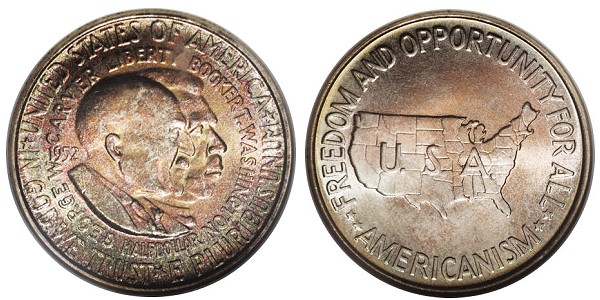
Congress’s fear of communism collided with its fear that certain leaders in the African-American community might hold such beliefs got us the Carver Washington Commemorative, which touts “AMERICANISM”.
MOTIVES OPEN TO INTERPRETATION
Despite the fact that the Booker T. Washington half dollars failed to deliver the kind of financial windfall Phillips was expecting, he decided to go to the well again and get legislation passed to authorize a new commemorative coin. This coin would honor not just one but TWO great black figures, this time adding the revered botanist and agricultural scientist George Washington Carver, a friend and colleague of Booker T. Washington. Intriguingly, an incongruous anti-communist theme was tied to the coin, ostensibly a tactic to win legislative approval. Seemingly well-intentioned, yet one may assume, still-racist legislators imagined the spread of communism within the Black community as a real threat to the American system, and in a stroke of political genius Congress thought that a good way to stem the red tide was to issue novelty half dollars.
By the end of the Carver Washington production run, disillusionment with S. J. Phillips had set in, not only with his white legislative benefactors but also among prominent members of the black community. They saw him as nothing more than a shameless self-promoter with no real intention of doing anything but enrich himself. Nothing crystalizes this more than a letter dated “spring ’53” written to author Ralph Ellison by his friend Albert Murray:
“One S. J. Phillips of the Booker T Fourbits & the Booker T Birthplace & Booker T Sales Agency & George Washington Carver Birthplace notoriety….” He goes on to say, “Here’s a sonofabitch who’s been literally swindling off thousands of dollars from people who thought they were making contributions to Tuskegee and Tuskegee Sponsored projects…. Here’s this anachronistic fourflusher (perhaps the greatest smoke defrauder of our day-who else has ever gotten the US Government to make a MILLION HALF-dollars and let him SELL them for WHOLE dollars and more?) whom any kind of investigation would land in the pen…. Here he is with his good southern whitefolks completely sold and gone on the idea that HE is not only the greatest living exponent but also the ONLY living heir and continuator of the true gospel of Booker T Washington (most of Booker T’s offspring work for him- for whiskey money)….”[9]
Running counter to this impression was some genuine good work on the part of Phillips and his group. During his stewardship, the Booker T. Washington Birthplace Memorial made a number of improvements to the birthplace site, including road improvement, the construction of new buildings, the renovation of existing buildings, and the construction of a replica of Washington’s birth cabin. Phillips also corrected a glaring wrong; by donating land to the local school board, he ensured that a black elementary school could be built to the same standards as the local white schools.[10] This school closed in 1966, after Virginia’s segregationist legislature and governor relented on Massive Resistance, Virginia’s effort to shut down public education in the state and establish private academies in order to subvert federally-mandated integration.
Ultimately, whatever self-valorization Phillips sought did not come to fruition. The sale of both commemorative coins didn’t generate enough revenue to fund the Booker T. Washington Memorial, and eventually Phillips’ stake was sold to the State of Virginia, which then sold it to the Federal Government. Washington’s birthplace became a National Monument (the best possible outcome, in our opinion). Financial promises he made, including to Portia Washington Pittman, Booker T. Washington’s daughter, were broken. Mrs. Pittman, brought on as Phillips’ partner to give him credibility, filed a lawsuit against him alleging breach of contract and that he owed her more than $20,000 of the promised $25,000. Mrs. Pittman said that she’d been paid only $3,900 plus an additional $350 in the form of 700 of the coins themselves[11]
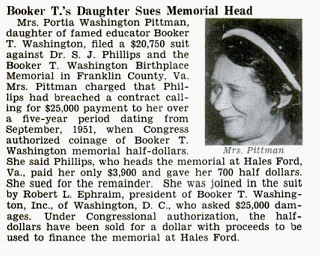
[12] One wonders if Mrs. Pittman is one of the individuals explicitly mentioned by Albert Murray in his letter.
Undaunted, the deeply-in-debt Phillips went back to the well a third time to get a Booker T. Washington Centennial coin legislated. By this time Congress had run out of patience with Phillips and the commemorative coin program. It would take twenty-eight years before Mint Director Donna Pope would helm the resurrection of the program.
DESIGN
Hathaway returned to design the Carver Washington half dollar. This time he adapted a design similar to that used on the 1936 Norfolk Bicentennial and 1937 Roanoke half dollars, both of which surrounded the central motif with rings of text. In the case of the Carver Washington obverse, Hathaway presented a side profile image of the two men in jugate. The date, which is presented in a modestly-sized font behind Carver’s ear, is practically lost in the scroll of inscriptions.
Hathaway’s original reverse, provided to Don Taxay for use in his book, An Illustrated History of U.S. Commemorative Coins (1967), is a cluttered mess of obvious jingoism and Phillips’ affiliated memorials; it read: “Booker T. Washington Birthplace Memorial, VA”, “George Washington Carver Nat’l Monument Foundation, MO”, “United Against the Spread of Communism”, National Americanism Commission”… all of which surround the seal of the American Legion.[13] Mercifully, this reverse wasn’t approved.
The approved design would eventually feature a not-quite-right map of the United States with the inscriptions “Freedom and Opportunity for All” and “Americanism”. Considering the target demographic and the social climate at the time, these words were the height of irony.
THE MARKET TODAY
Of the 2,4220,00 Carver Washington half dollars coined, 1,091,198 are known to have been melted[14], 94% of the known surviving population (“known” being the key word) comes from one of four issues: 1951 P, 1952 P, 1953 S, and 1954 S. The other eight issues in the series all have net mintages of 10,000 coins or below.[15]
The series wasn’t particularly lauded upon its release, and by all accounts, the lower mintage three coin sets sold out (none were returned to the mint for melting until 1954, when Phillips’ finances were especially dire), while the over-produced single coin offerings gathered dust. It was possibly more out of boredom than racial intolerance that the coins didn’t catch on with numismatists of the period. By the time the Act authorizing production of Carver Washington coins expired on August 7, 1954, the commemoration of Booker T. Washington had gone on for eight years, and except for the Iowa Centennial no one and nothing else had been honored on United States commemorative coins since the end of World War II.
Perhaps it’s because of the coin’s place as the last of the classic commemoratives that it fares better than the Booker T. Washington series. Or maybe it’s because Swiatek and Breen included the series in their list of The Big Six commemorative coins and series to invest in that a majority of the lower-produced dates were scooped up and coveted. The market today does not bear out Swiatek and Breen’s optimistic sentiment – there are far better plays to make in the classic commemorative series – but from a historical perspective, both the Carver Washington and Booker T. Washington half dollars are important coins and cultural artifacts. They are the first two U.S. issues to honor African-Americans and the only ones released before the mid-century Civil Rights Movement peaked in the 1960s.
The Acts that authorized them and the men who supported the creation of two of our nation’s most interesting coins reveal much about America’s struggle with race and liberty. By the time the next African-American appeared on US coinage, America was a much different place socially.
The story of African-American coinage continues next week with Part 2: Modern Commemoratives and Circulation Strikes.
Authors’ note: While preparing this piece we considered including many of the racist names used to describe the Booker T. Washington and Carver Washington half dollars by some members of the general public and numismatic community. It was a hard call. While we believe that history shouldn’t be swept under the rug no matter how unpleasant, we didn’t think it would be fair to report these derogatory nicknames without primary source verification that these terms were used at the time the coins were released. Proof of their existence can be found in Swiatek and Breen, though they are too modest to reveal what they are.
Charles: The last time I heard any of these names used was in 1999, when I was a regular at a coin shop near Tucson, Arizona. I don’t think these names would surprise anybody.
FLIP OF A COIN:
Cherry Picker’s Guide?: Are you considering putting together the Ultimate 1981 Mint set that Hubert and I wrote about last week? If so, look out for the “Type D” reverse Washington quarter. Internet clad expert CladKing, rightly notes that “About one in 160 has a type “D” reverse which was later modified and used on all quarters after 1984. It is quite different with the Pick-Up Point being a greater distance between the right side of the N in UNUM and the eagle’s head.” Happy hunting!
The Citizens Coinage Advisory Committee met Tuesday, June 26th, 2012, at the U.S. Mint Headquarters in Washington, D.C. to review candidate designs for the 5-Star Generals Commemorative Coin Program and the Navajo Code Talkers Recognition Congressional Gold Medals. The 5-Star Generals Commemorative Coin Program was prescribed by Public Law 111-262, signed October 8, 2010. Proceeds from the sale of the coins will go to the General Staff College Foundation to help finance the Command and General Staff College.
Still soaring after all these years: Peter, the Philadelphia Mint’s eagle, who, according to legend, lived at the first Mint for six years before getting caught in a coining press. Mint artists used the bird for a number of years as a model, and he continues to soar (in stuffed form, of course) over the entrance way of the Philadelphia Mint.
Charles Morgan is a member of the Ike Group and is working with Rob Ezerman on GradeView™: Eisenhower Dollars and with longtime collaborator Hubert Walker, on a number of other projects, including the Registry Set Collector’s Guide to US Coinage, which will be published sometime next year.
Hubert Walker’s background is in the classics. A nationally-recognized Latin scholar when younger, Hubert’s interest in history and symbology connects him to modern coins as well as ancients. He also likes the movies, among other things.
Charles and Hubert’s informative columns appear weekly at CoinWeek.com.
[1] Swiatek, Anthony and Walter Breen. The Encyclopedia of United States Silver & Gold Commemorative Coins: 1892-1954. ARCO, 1981. Print.
[2] White, Compton I. “Laying the Foundation for a Stronger America Through Leadership and Racial Team Work.” Congressional Record: Proceedings and Debates of the 81st Congress, Second Session. 1950. Comments reprinted in its entirety in Anthony Swiatek and Walter Breen’s The Encyclopedia of U.S. Commemorative Coins 1892-1954. ARCO. 1981. Print.
[3] Swiatek and Breen, 250.
[4] Ibid.
[5] Ibid.
[6] Ibid.
[7] Ibid.
[8] Ibid.
[9] Ellison, Ralph, Albert Murray, and John Callahan. Trading Twelves: The Selected Letters of Ralph Ellison and Albert Murray. Random House. 2011. Ebook.
[10] Nowak, Lisa, H. Eliot Foulds, and Phillip D. Troutman. “Cultural Landscape Report for Booker T. Washington Monument: Site History, Existing Conditions, Analysis, and Treatment. Olmsted Center for Landscape Preservation. 2003. .pdf
[11] “Booker T’s Daughter Sues Memorial Head”. Jet Magazine, Chicago; 26 Feb 1953. Print.
[12] Ibid.
[13] Taxay, Don. An Illustrated History of US Commemorative Coinage. ARCO. 1967. 252.
[14] Swiatek and Breen, 259.
[15] Ibid.
(c) 2012 Charles Morgan and Hubert Walker
This article originally appeared at www.coinweek.com.

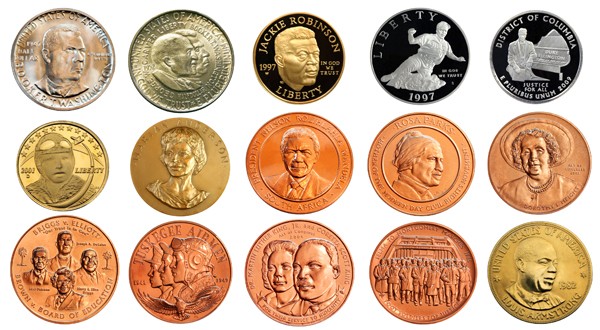

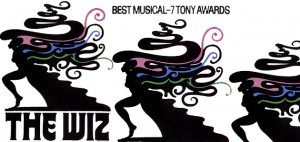
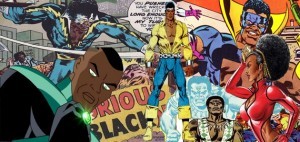

0 Comments